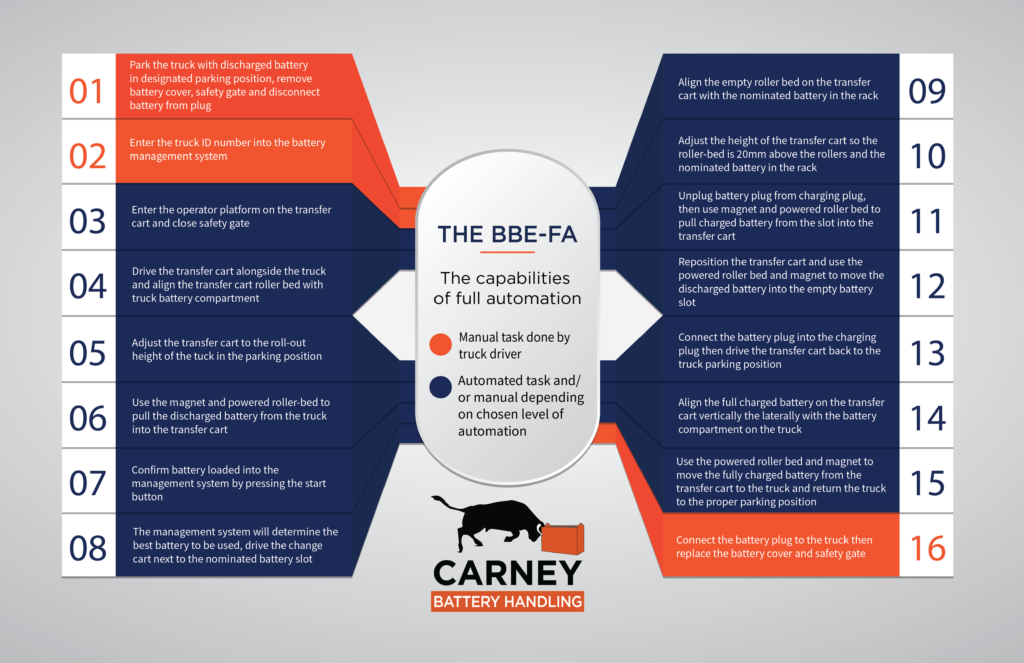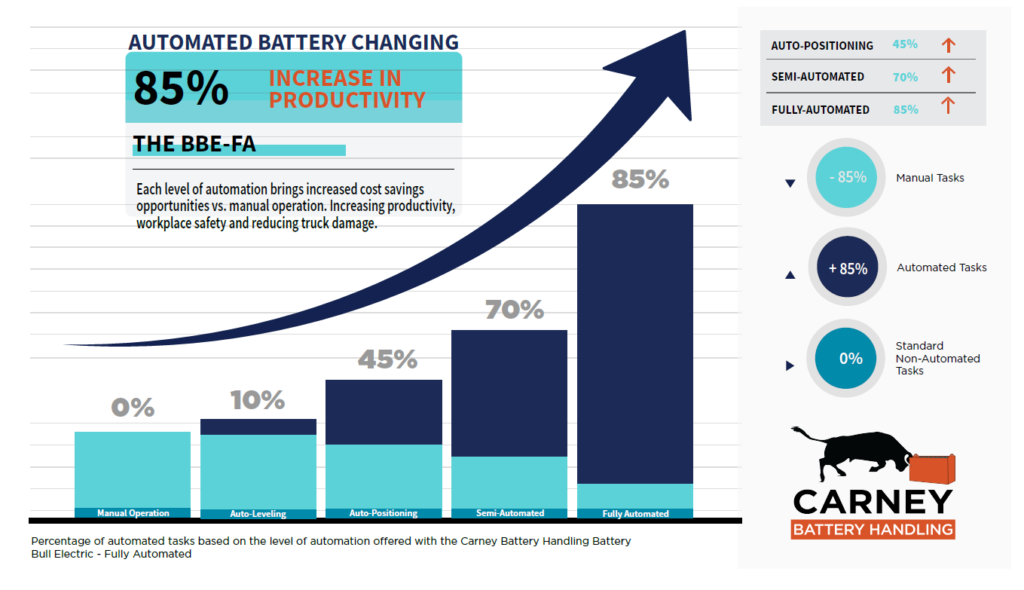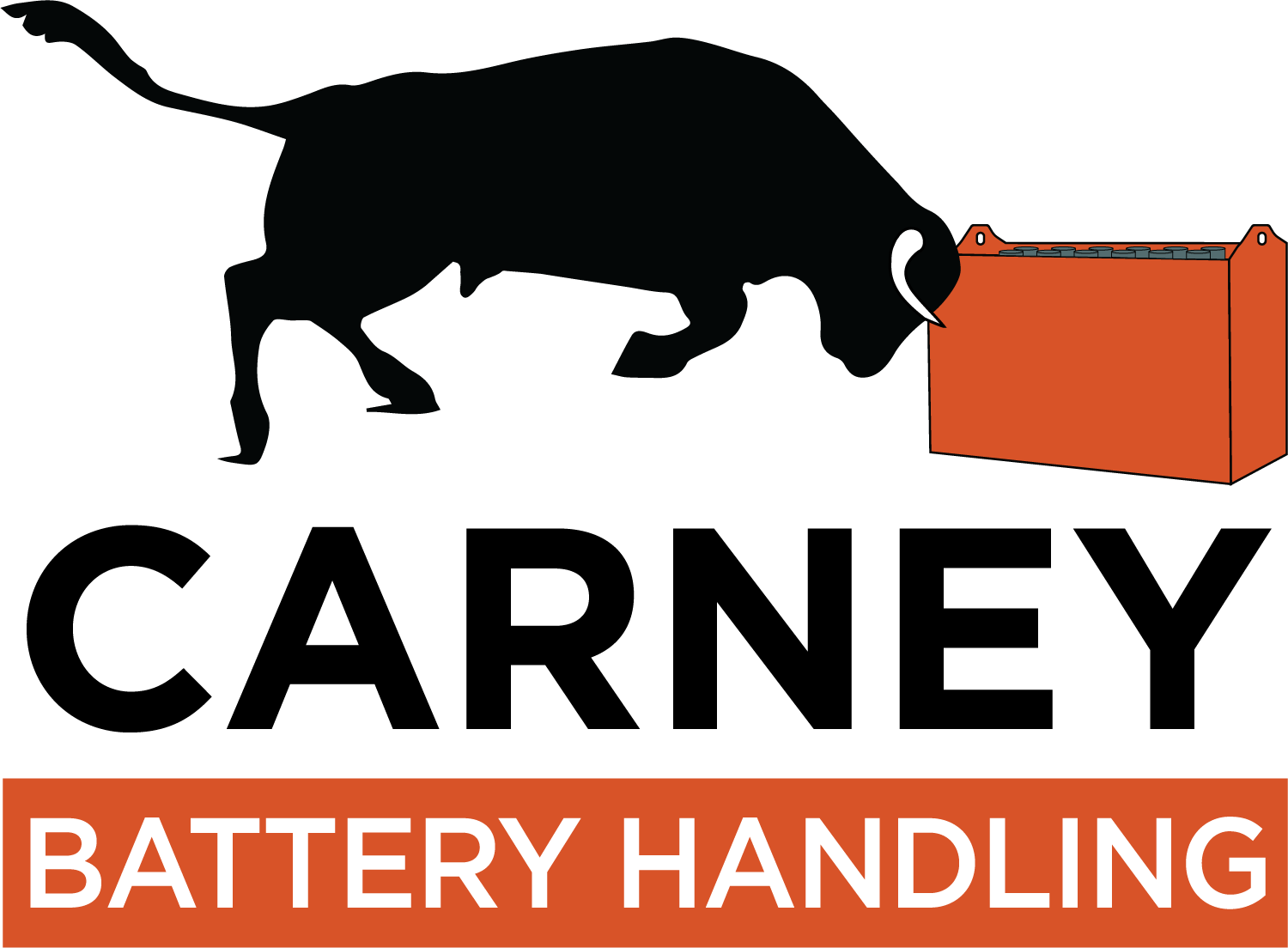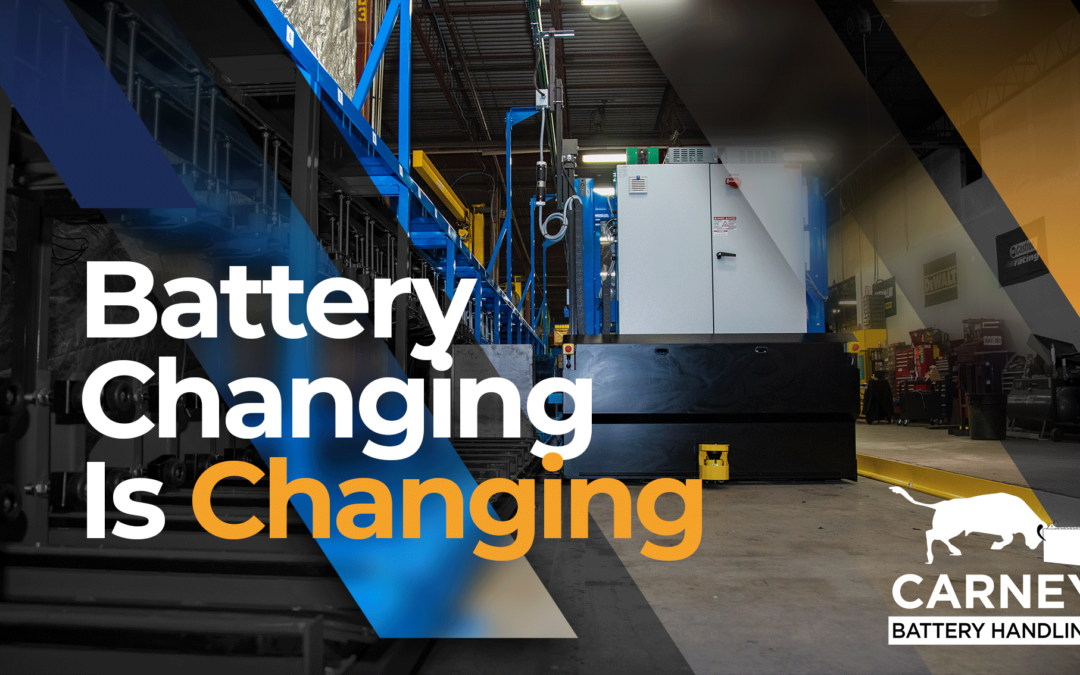Written by John Lawton and James Lane
Carney Battery Handling Ltd. (CBH) has developed a fully automated battery change system for mainstream material handling equipment. Based on a long pedigree of automated battery change solutions for automated guided vehicles (AGVs) established in 2004, CBH has utilized its expertise in this technology and made it available for forklifts, pallet trucks, and warehouse trucks.
Businesses that have a fleet of electric material handling equipment such as pallet trucks, order pickers, reach trucks and forklifts, and operate a multi-shift work pattern, are remarkably familiar with the need for spare batteries and battery changing during the working day.
Managing a material handling fleet with spare batteries can be complicated and expensive if not managed correctly. Historically, the predominance of batteries used in these applications were flooded lead-acid with 8-12 hours recharge with the need for regular maintenance, such as topping up with water. There have been major advancements in lead battery technologies over the years with the introduction of low or zero maintenance technology, higher capacity for longer run-times, and faster/opportunity charging capability with advanced lead solutions such as Thin Plate Pure Lead (TPPL). The industry has also seen the emergence of alternative technologies like hydrogen fuel cells and lithium-ion batteries, both giving the opportunity to ‘refuel’ in the truck. These new technologies can be extremely attractive for businesses that have the infrastructure and refueling time needed. However, for businesses that operate at a high intensity and cannot support trucks being ‘on charge’ for even a short period of time, or it is impractical to install the required infrastructure, a battery-changing system is what they need.
Major Considerations
Safety
Traction batteries are HEAVY and mainly fall outside the manual handling regulations in place in most countries. Of paramount importance is the safety of your truck operators and other staff involved in battery changing. You need a system that provides the highest degree of safety and ease of operation. You also want a system that prevents damaging your assets such as batteries, forklifts and ancillary equipment.
Battery Change Time
You have recognized that changing batteries in your material handling equipment is an essential part of keeping your business running in your extended or multi-shift operation but have you considered that the productivity of a truck stops from the time it leaves the workstation to the time it returns with a fresh battery? In addition to the loss of truck productivity, you have the cost of the truck driver and battery room operator to consider. Keeping that down-time as low as possible can have a significant impact on your profits! Fully automated systems score points in this area.
How Much Space Will I Need for a System?
Warehouse and manufacturing space is expensive. CBH puts a big focus on reducing the amount of space you need to devote to your battery charging room. New construction warehouses today often have internal heights of 10m or more to utilize high level storage. It makes sense to adopt a similar approach with your battery changing system and CBH can design multi-level battery storage and charging racks, which will release valuable floor space for use by your core business. We have proven results where we have reduced customers battery room size by as much as 70%.
Deciding to invest in a battery changing system will bring operational and cost benefits to your business. Choosing the right supplier is also critical – get it wrong and it can be very inconvenient and expensive.
Not All Battery Handling Systems Are Born Equal!
CBH has been designing and manufacturing innovative and robust battery handling solutions for over 35 years. All engineering designs, customizations and automation development is done in-house. This provides us with complete end-to-end management and the ability to offer our customers added value by keeping their needs at the forefront.
At CBH, we are committed to providing the highest level of service, including consultation to discuss your requirements, an overview of the types of systems available, and design proposals that meets the needs of your business today and in the future.
As with any other piece of mechanical equipment used in your business, battery handling equipment needs regular servicing to maintain its reliability and efficiency. CBH has a network of distributors and service partners across the world to keep your equipment running at its best, who are a phone call away if you need a spare part or repair. Our battery racks include a 10-year warranty, plus 10-year warranty on all our electro-magnets.
What Is a Fully Automated Battery Changing System?
So-called fully automated systems appear in many guises on the market. Some claim to be fully automated but only certain aspects are automatic, as they still rely on having an operator on the machine to perform specific functions.
For example, if you compared this to the automotive sector, you buy an automatic car but the only part that is automatic is the gear box. Perhaps you can add-in cruise control as well, but you still need a driver to steer the vehicle and avoid hazards. Many people understand automobiles but do many of us understand battery changing? Simply put, it is important to understand the functionality of the product you are buying and matching it with the benefits you require.
CBH’s fully automated system is truly what it states to be, and operates completely driverless. In fact the truck driver whose battery is being changed stands on a pressure mat many metres away from the battery changing operation once he has prepared his truck for a battery change.
Let us take a look at the battery changing process flowchart:

Why Choose a Fully Automated System?
Having looked at the important elements in system design and operating parameters, let us now take a look at the benefits of using a fully automated system.
The Hard Facts
- You can reduce the time it takes to change a battery, resulting in less down time for the truck and driver and a lower impact on lost productivity
- You do not need a dedicated operator on the change cart, it drives itself. Therefore, you can redeploy these staff. Note that a 24/7 operation typically requires five full-time staff to man the battery room, accounting for holidays and sickness coverage. This is a huge potential saving in man hours
- Space saving – multi level systems can release valuable floor space for your core business
The Hidden Benefits
- Fully automated change carts have precise auto positioning which means less damage to your assets, including batteries, plugs and cables, battery storage racks, trucks and even the change cart itself
- No more manual handling of heavy batteries eliminates any possible risk of injury to your staff resulting in sickness cover costs, incident reporting and re-training costs, not to mention exposure to costly personal injury claims

Let’s Talk Numbers
Understanding the benefits means you can start to work out the cost savings.
Let’s look at a typical grocery distribution centre operating 24/7, moving an average of 1 million cases of goods per week with 100 trucks, a fleet of 300 batteries (1 battery per shift per truck) and a battery changing room with a man-aboard change cart.
We will convert this to a multi-level fully automated system;
- Firstly, the staff that are dedicated to work in the battery room can now be redeployed – this will save 168 hours of labor cost per week.
- Precision and speed of change should reduce battery changing time. If you shave as little as 2 minutes off each battery change you will get the following:
2 minutes x 200 battery changes per 24 hours x 7 days = 46 hours per week
This means your trucks and drivers are standing idle in the battery room for 46 hours less per week.
- As a result of Point 2, your productivity increases and you have 46 hours worth of additional cases picked.

One can also factor in some cost savings for using less floor space and put a value on some of the hidden benefits, such as damage and staff sickness.
When we add it all together, fully automated systems offer an impressive return on investment.
In an age when automation is becoming an increasing part of our daily lives, why would you not consider automating your battery room too?
The New Normal
Every distribution engineer around the world is asking themselves what is the new normal going to look like in every aspect of their business. We are going to focus on one. What is the most cost-effective solution to power my industrial forklift fleet? Ask ten people and you will probably get ten different answers!
The questions are many and the answers are few, however they all have one common theme; what will be my total cost of ownership over a 4-5 year period and is this a capitol purchase or a part of my equipment lease?
The list below are the prevailing questions based on our interactions with large national account end-users. Consider these for your operations.
- How many shifts will we run? (Typically, 2-3)
- Do we have time to opportunity charge? If so, how do we organize the charge times, floor space and power distribution to the chargers?
- Is our forklift demand too high for opportunity of fast charging? How may kilowatts can reasonably be returned to the battery during your work shift?
- Do we size the fleet for our annual peak shipment demands or rent additional equipment during these busy seasons?
- How will we power our Material Handling Fleet (MHE) fleet? Lead Acid Batteries / Hydrogen Fuel Cells / Lithium-Ion Batteries/ Thin Plate Pure Lead.
- What are my annualized costs? Consider equipment, energy costs maintenance and labour to operate my fleet.
- If I am a 3PL provider, how long is my contract with this customer and how much infrastructure cost do we want to spend in a leased building? Can we re-deploy these assets to another location or are they site specific?
- How much is the total energy cost to operate my fleet (cost per kilowatt or BTU in the case Hydrogen)?
When you weigh-up and measure your options the fully automated battery changing system is a safe effective and, in many cases, the lowest cost of ownership solution to support your MHE fleet.
Questions? Register for our FREE webinar April 7th 2021 @ 10:00AM EST

